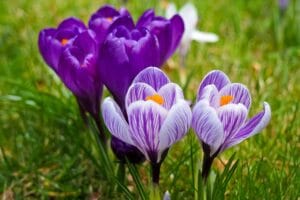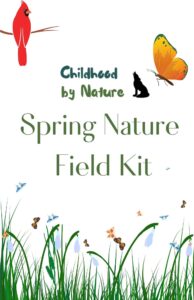
They are among the first signs of spring. They are usually just the thing to brighten your day (or year). Delicate, intricate, beautiful blossoms are a reminder that nature is ever-changing, and, yet, we can always count on it to bring us happiness.

Stop & Smell the Flowers
Teach your children a lesson from cultures such as the Japanese culture, where spring blossoms are celebrated with the traditional custom of Hanami, which means ‘flower viewing.’ This is an opportunity specifically to take in the beauty of flowers. Reserve a spring day each week to Hanami. Choose an arboretum, local park, a walk around the neighborhood but this time, don’t walk past the flowers but be intentional about absorbing the beauty of spring blossoms.
To help you get started, let’s go deeper in the magic of blossoms!

What are flowers?
Flowers, also known as blooms or blossoms, are the reproductive organs of plants. When pollinated, flowers develop into fruits containing seeds. Pollination can happen by wind but it often happens by a vector, such as an insect or animal. But in order to entice pollinators, these flowers must attract them with their looks or scents and they must provide them with a bribe of sorts—their favorite foods: nectar and protein.
Why are they so pretty?
Go ahead and admire that beautiful delicate flower. Most flowers are attention seekers. They are designed to attract pollinators with their bright colors and alluring scents. Since most pollinators fly, the colors of a flower must capture their attention before they whizz by, passing them up. So, to a flower, the brighter and showier, the better.
Like most things in nature, a flower’s color is not random. It is a carefully evolved trait. A flower’s color depends on the type of pollinator it is designed for. Hummingbirds prefer red, pink, fuchsia, or purple flowers. Bees see color five times faster than we can, which assists in spotting food at high speeds of flight. They can see blue, green, orange, yellow and UV, but find it very challenging to see red especially on a green background. Butterflies are nearsighted and see the colors white, pink, purple, red, orange, yellow and UV, but can also struggle to distinguish red from a green background. Night-blooming flowers take advantage of pollinators active at night, like moths and bats. Since they don’t see colors, these flowers are not as colorful.
Why do they smell so good?
As we find so often in life, looks are usually not enough. A flower will do whatever it takes to draw the attention of a pollinator. The alluring scent is simply a means of attracting much-needed pollinators for flower pollination to occur.
Why are flowers different shapes?
We’ll give you one guess... Yes, you’re right. It’s pollinators!
Yes, you’re right. It’s pollinators!
Like color, a flower’s shape is a result of its co-evolved relationship with its pollinators. Co-evolution comes about when two species are dependent upon one another for survival. Each flower's individual shape has evolved to allow for the pollination process.
For example, flowers pollinated by beetles tend to have larger and more open flowers that provide an easy landing pad since beetles are not as agile in flight as other flying insects. Butterflies prefer a broad landing surface, such as sunflower or daisy can provide. They use their long proboscis to access the nectar they seek.
Hummingbirds like flowers shaped like trumpets. This shape offers them space to hover under or above the bloom while they drink the sweet taste of nectar while being a perfect shape for their long bills.
Bees, on the other hand, are drawn to a broad range of shapes and sizes of flowers. These agile pollinators can grip the flower with their feet, sometimes even upside down, as they feed on the nectar, with their proboscis, and collect the pollen.

Why don’t flowers bloom all year round?
Producing flowers, fruits, and seeds is not easy! Plants have to dedicate a ton of their resources and energy to grow these specialized organs. Because of this, plants are smart enough to focus their efforts during the time of year when conditions are best for their success and survival.
How do flowers know when to bloom?
Plants blossom at different times because of several factors such as the weather, temperature, and the amount of sunlight the plant receives. Altogether, these send a signal to the plant to start producing flowers, or not.
Recently, scientists have been uncovering the mystery to exactly how a plant coordinates its flowering ability. They’ve learned that flowers know when to bloom because of a gene named Apetala1. Apetala1 triggers the reproductive development of a plant, telling it when it's time to start blossoming. Apetala1 generates the proteins that in turn switch on more than 1,000 genes involved. So a plant blooming with flowers has an active Apetala1, while a plant carrying inactive Apetala1 genes has very few flowers, if any, with leafy shoots growing in place of blossoms. It is fascinating that a single gene is all it takes to make a plant start producing flowers!


We hope you and your family have dug a little deeper with spring blossoms with us! A Hanami is a wonderful family activity that will help you all learn about vital local flowers that make your spring season a colorful joy. When you head out on your Hanami, share these fascinating facts with your children, encourage them to take the time to explore and wonder, pay tribute with a sketch, field observations or a poem. And be sure to check out our Spring Nature Field Kit and take it along!
If you want to get to know your local blooms ahead of time, check out these great resources!











